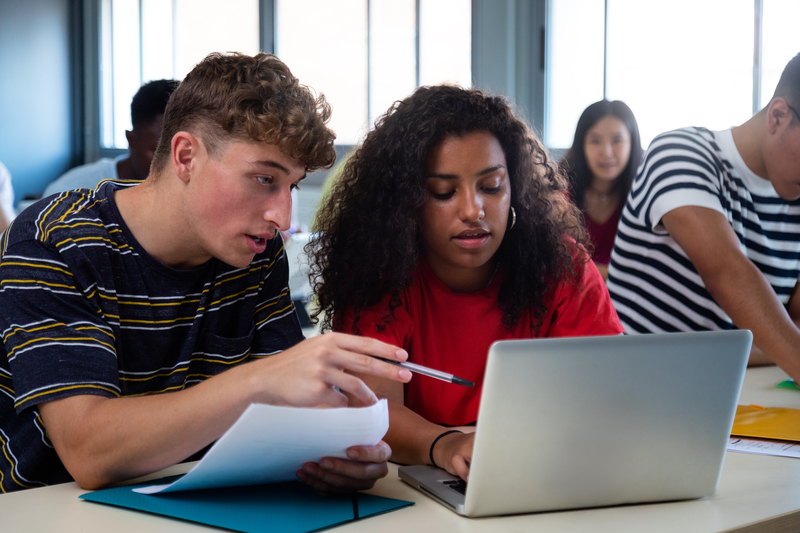My students and I met on a cold November morning, paint buckets and rollers in hand. This was the biggest creative risk we had taken as a group, and I wasn't sure it would work.
Our wall-painting project started when a team of students at Frank Borman Middle School in Phoenix, where I was teaching, conducted a community-needs assessment as part of a co-curricular program. One of the things they discovered from surveying people in the school's neighborhood was that many of these individuals felt unsafe because of the large amount of graffiti on our campus. Every time custodians painted over the graffiti, it reappeared within 24 hours.
I had introduced this team to the concept of design thinking. Design thinking is a flexible process for getting the most out of the creative process. It is used in the arts, in engineering, in the corporate world, at universities, and in social and civic spaces. With design thinking, students move from an initial place of empathy toward inquiry, research, ideation, and eventually prototyping and revision. My students worked through the design-thinking process and pitched ideas to solve the graffiti problem—but every idea entailed obstacles. Security cameras proved too costly. Students sketched out a schedule of "graffiti-watching shifts," only to find that the area already had a neighborhood watch program.
The team felt stifled by their limited funds (we could get some paint donated, but that was about it) and manpower. They brainstormed fundraising ideas, but realized it would take way too many car washes to pay for a full-scale security system.
"Is there a hidden opportunity you're not seeing?" I asked. "Something low-cost we could do that would prevent taggers from doing graffiti?"
My students sketched out more ideas—fences, booby traps, and several really bad ideas—before landing on a simple concept. What if they looked into the attitudes and beliefs of taggers? Students researched articles, read online forums, and watched mini-documentaries that included interviews with taggers. In one case, they were able to interview a former tagger who was now paying restitution for his crimes. The results were surprising. Many taggers viewed themselves as artists embellishing boring industrial spaces with their names. These scrawls weren't threats by gang members, but messages from people wanting to be known. This didn't excuse the vandalism, but it changed the students' perceptions of it—and led to a bold idea.
One girl approached me with a new two-page plan. I didn't get a chance to read it before she blurted out, "We'll cover it with art. We think the taggers will leave the art alone."
"Like an art gallery?"
"No, murals. We'll have murals everywhere."
She then launched into a five-minute explanation of what our campus would look like when the team was finished. We pitched the idea to our principal, who gave us the green light immediately.
Thus began a massive mural project carried out in the after-school portion of the co-curricular program. Small teams planned everything from materials to processes to the overall design concept. We landed on the idea of images that addressed immigration and reminded us that we're a patchwork of cultures. One boy sketched the entire design, and we used the grid system to scale it onto one frequently tagged wall. We painted this wall on weekends and after school. Each time, I waited for that crushing moment when our mural would be vandalized. But it didn't happen.
Taggers continued to paint graffiti in other areas of the school, but the mural had a sort of force field of creativity and student voice around it. For an entire summer, the finished mural remained as an un-tagged statement of unity for the neighborhood to see. The next year, we painted two more murals; within three years, we'd painted five. These artworks became a source of pride. Little kids walking to the nearby elementary school would stop in their tracks and point. Moms would say, "Someday you'll get to paint one."
My students and I could have spent a fortune on security cameras. We could've attempted a large-scale public relations campaign and lobbied for nightly surveillance around the school. However, we didn't have the human or financial resources to pull off those solutions. Instead, we found a more innovative solution by embracing the power of limitations. Working within the constraints of a small budget led students to design a solution that was more creative and sustainable. It was a lesson in the power of creative constraint.
Looking for the "Adjacent Possible"
The frequently heard advice "think outside the box" conjures up an image of the lone inventor in a lab creating something radically different that will rock the world. However, creativity isn't always like this. Instead of thinking outside the box, innovation often involves thinking differently about the box. Observe a child playing with a refrigerator box. It becomes a car, an airplane, a robot suit, and a tunnel. Think of Minecraft or LEGOs. They're essentially variations on stacking boxes, yet, their simplicity and lack of options unleashes the power of creativity.
Creative constraint happens when you run into barriers that force you to find a new route. This process involves problem solving, systems hacking, and divergent thinking. True, creativity can involve creating something on an empty canvas or blank page. But it can also stem from a roll of duct tape, some cardboard, and a series of limitations that ultimately lead to a breakthrough.
Steven Johnson borrows the evolutionary idea of the "adjacent possible" to describe innovation and problem solving, noting that, "The adjacent possible is a kind of shadow future, hovering on the edges of the present state of things, a map of all the ways in which the present can reinvent itself."
Instead of moving in leaps and bounds, innovative thinkers often move just beyond what they already know by engaging in iterative thinking. Innovation might involve exploring one new variation on an old idea or combining two seemingly unrelated ideas, but innovators still work within the box.
This view of creativity is often less about bold new ideas and more about tinkering. Every time someone mashes up ideas or looks for hidden opportunities, they're thinking differently about the box. Most of the time, such tinkering doesn't work. But as people push through various iterations, they edge further along the adjacent possible and closer to the solution. Tinkering isn't limited to any specific subject area. When my students worked on a Tiny House project, they tinkered with the space, moving items back and forth and trying to figure out what worked. They played with the objects, seeing if they could use the space in a different way. Eventually, it clicked. Students used this same tinkering approach when they worked on engineering challenges, as they faced a specific design challenge and tested out new ideas rapidly until they landed on a solution. However, students also tinkered when engaging in blogging or when filming documentaries.
Seeing Limitations as Design Features
The constraints that limit a product's design often become the very features that make a product creative. Consider Baltimore's Oriole Park at Camden Yards. For years, cities built donut-shaped symmetrical stadiums in the furthest reaches of the suburbs. However, Baltimore had to design a ballpark within the confines of a quirky-shaped lot in its Camden neighborhood. Instead of demolishing the B & O Warehouse, they incorporated it into the outfield design, creating an asymmetrical outfield and opening the left-field view to the city skyline.
We see the same trend with the "Chopped"-style chef competitions, where contestants develop creative recipes because they're forced to use specific ingredients. To take a more weighty example, the NASA engineers behind the Apollo 13 launch had to design an innovative way for the astronauts to make it back to Earth using only the spare parts the crew members had on that spacecraft.
As educators, we can inspire students to view creative constraint as a positive force for innovation. When faced with a limitation, I use these questions with students to reframe the problem as a potential design opportunity:
▪ What is a different angle to this problem? What are we failing to see right now?
▪ What hidden opportunities does this challenge offer? Could there be a positive side to this that we're failing to see?
▪ What parts of these limitations should I actively resist or try to remove? What parts should I accept and work around?
▪ What part of this can I tweak or change slightly?
▪ Is there some kind of material or resource within this system that I can use differently?
▪ What parameters I can work within?
Often, students will go through these questions in the initial phase of a design-thinking project as they define the problem and shift to inquiry. However, they also work through these questions when they ideate, create, and revise.
Developing Divergent Thinking
Divergent thinking is a spontaneous, free-flowing, nonlinear thinking process. When you're thinking divergently, you're looking at things from new angles. You're finding new uses for common ideas and objects. You're rewriting the rules and questioning everything. Oddly enough, this type of open, free-flowing mental process is often activated by an external limitation.
Creative constraint is a disruptive force that pushes people to think divergently by finding work-arounds, using things in new ways, and connecting seemingly unrelated ideas. The architects of Camden Yards had to think divergently to design a ballpark that would fit within the site's constraints. Similarly, my students had to think divergently about both what graffiti meant to the tagger and various ways a wall could be protected from vandalism.
So how can educators use creative constraint strategically to encourage students to think divergently?
Limit Materials
Although a 3–D printer might be the most powerful tool for prototyping, some of the best maker projects require students to use everyday items like duct tape, marbles, rubber bands, and paper clips. Here, students are forced to think divergently about everyday items as they design something new.
I recently worked with a group of teachers who were frustrated that their maker space didn't have the best new gadgets. I gave them a challenge: Create a game that would be so compelling to play that people would choose it over their digital gaming devices. They could only use the items at their tables. The caveat was that they didn't have any items at their tables: They had to use items from their backpacks, bags, and purses.
An hour later, we had highly engaging games that involved rubber bands, dental floss, and Altoid containers. Participants found unconventional ways to use their items.
Limit Options
The idea behind limiting options is to put tight parameters on certain tasks and encourage students to find specific work-arounds that incorporate divergent thinking. This might involve limiting the quantity of the work. Teachers might require students to create a six-word story or 25-second video. They might have to design a bridge with fewer items or solve a math problem in fewer steps. Within these constraints, students have to be more intentional about what they are creating. They often develop alternative methods and strategies.
Teachers might also create specific rules for an assignment, such as asking learners to solve a math problem without using paper or pencil. This mental math process allows them to find new strategies. Students might have to give a visual definition of a concept without using any words, and suddenly they're comparing concepts using symbols and imagery they hadn't considered before.
In some cases, a teacher might limit the amount of time available for a task so students must engage in rapid prototyping as they attempt to solve a problem. They might build a bridge, design a self-propelled car, or make a solar oven. By working within a tight time constraint, they don't over-analyze plans. Instead, they move rapidly through ideas, pushing past their initial attempts and landing on something new.
Note that these constraints aren't designed to frustrate students. Instead, they should be challenges that encourage students to take creative risks. Use approachable phrases like, "I wonder if you could ___ by only using ___" or "We're going to see if it's possible to do ___ without using ___."
Helping Students Embrace Creative Constraint
Students often struggle with creative constraint. It's hard to view problems as possibilities. In many cases, students are risk-averse and exhibit a fixed mindset around their abilities to tackle problems. We can encourage students to embrace creative constraint with these tactics:
Allow for mistakes and revision. The traditional school system encourages students to solve problems correctly with the least amount of effort. Between grading systems and curriculum maps, we place a high premium on getting the answer right the first time. But problem solving in the real world is often about thinking divergently and working through iterations. If we want students to embrace creative constraint, they need permission to make mistakes and go through the revision process in a leisurely way.
Keep the constraints reasonable. Mihaly Csikszentmihalyi notes that a task leads a worker to the mental state called flow when it has a high challenge level and the worker has a high skill level. A task that's too challenging can lead to anxiety; one that's too easy, to boredom. That's why it helps to limit the types of constraints you build into a project or assignment. For example, if you have a limit on time and resources, the task itself should be something that feels doable for students (like building a model bridge).
Honor student agency. Trevor Muir, a teacher in Grand Rapids, Michigan, who uses project-based learning, had his students film a series of six-minute documentaries with World War II veterans. Ultimately, they created a red-carpet event at a local movie theater. Although they faced tight constraints—a packed curriculum map, the lack of a studio, and no multimedia editing software—these students owned the creative process and found a way to film their movies with smart phones while tracking their mastery of the content standards. The result was something more personal and approachable than would've resulted if they'd tried to create a high-budget, highly edited documentary.
Focus on intrinsic motivation. Students are more likely to embrace creative constraint if they're solving a problem they find meaningful. In the case of the mural project, my students cared deeply about their community and were personally invested in the results. Sometimes motivation is less profound. I used to do MacGyver-style challenges in which students had to complete a challenge in 45 minutes using 4–6 available items. They found the challenges so intriguing that they embraced both the time constraint and the material limitations.
The Payoff
Creative constraint can be frustrating for teachers and students. It's challenging when systems don't work or when resources aren't available. And we don't want to fall into the trap of using creative constraint as an excuse for underfunding projects or tolerating policies that short-change kids. However, our students will work in a world in which they have to solve complex problems and design innovative solutions. When they embrace creative constraint, they grow into the creative, critical-thinking problem solvers we know they can be.








